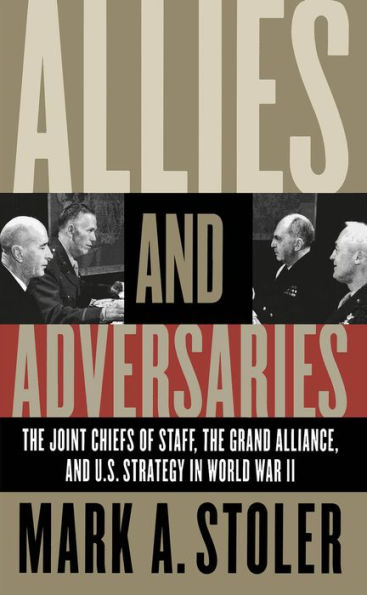During World War II the uniformed heads of the U.S. armed services assumed a pivotal and unprecedented role in the formulation of the nation's foreign policies. Organized soon after Pearl Harbor as the Joint Chiefs of Staff, these individuals were officially responsible only for the nation's military forces. During the war their functions came to encompass a host of foreign policy concerns, however, and so powerful did the military voice become on those issues that only the president exercised a more decisive role in their outcome.Drawing on sources that include the unpublished records of the Joint Chiefs as well as the War, Navy, and State Departments, Mark Stoler analyzes the wartime rise of military influence in U.S. foreign policy. He focuses on the evolution of and debates over U.S. and Allied global strategy. In the process, he examines military fears regarding America's major allies—Great Britain and the Soviet Union—and how those fears affected President Franklin D. Roosevelt's policies, interservice and civil-military relations, military-academic relations, and postwar national security policy as well as wartime strategy. "An important book that grapples with some of the central questions of America's involvement in the Second World War. It deserves to be read both inside and outside of academia. . . . This is military-diplomatic history at its best.—Reviews in American History"A matchless insight into the nature of policymaking, as fresh as it is thorough. . . . Indispensable for understanding the way the war was conducted at the highest levels. . . . Stoler's work is seminal, forcing us to rethink radically much about the war we thought we knew so well.—Intelligence & National Security"A prodigious work of research and analysis on US foreign and military policy, and on strategic planning for World War II. It is a gold mine of information.—Parameters"A lucid, logical examination of US military thinking about the world from the late 1930s through to the end of the Second World War.—Times Literary SupplementFormed soon after Pearl Harbor, the Joint Chiefs of Staff were officially responsible only for the nation's military forces. Their functions grew to encompass a host of foreign policy concerns during World War II, however, when the military voice assumed an unprecedented importance. Analyzing the wartime rise of military influence in U.S. foreign policy, Mark Stoler focuses on the evolution of and debates over U.S. and Allied global strategy. In the process, he examines military fears regarding America's major allies—Great Britain and the Soviet Union—and how those fears affected President Franklin D. Roosevelt's policies, interservice and civil-military relations, military-academic relations, and postwar national security policy. —>
During World War II the uniformed heads of the U.S. armed services assumed a pivotal and unprecedented role in the formulation of the nation's foreign policies. Organized soon after Pearl Harbor as the Joint Chiefs of Staff, these individuals were officially responsible only for the nation's military forces. During the war their functions came to encompass a host of foreign policy concerns, however, and so powerful did the military voice become on those issues that only the president exercised a more decisive role in their outcome.Drawing on sources that include the unpublished records of the Joint Chiefs as well as the War, Navy, and State Departments, Mark Stoler analyzes the wartime rise of military influence in U.S. foreign policy. He focuses on the evolution of and debates over U.S. and Allied global strategy. In the process, he examines military fears regarding America's major allies—Great Britain and the Soviet Union—and how those fears affected President Franklin D. Roosevelt's policies, interservice and civil-military relations, military-academic relations, and postwar national security policy as well as wartime strategy. "An important book that grapples with some of the central questions of America's involvement in the Second World War. It deserves to be read both inside and outside of academia. . . . This is military-diplomatic history at its best.—Reviews in American History"A matchless insight into the nature of policymaking, as fresh as it is thorough. . . . Indispensable for understanding the way the war was conducted at the highest levels. . . . Stoler's work is seminal, forcing us to rethink radically much about the war we thought we knew so well.—Intelligence & National Security"A prodigious work of research and analysis on US foreign and military policy, and on strategic planning for World War II. It is a gold mine of information.—Parameters"A lucid, logical examination of US military thinking about the world from the late 1930s through to the end of the Second World War.—Times Literary SupplementFormed soon after Pearl Harbor, the Joint Chiefs of Staff were officially responsible only for the nation's military forces. Their functions grew to encompass a host of foreign policy concerns during World War II, however, when the military voice assumed an unprecedented importance. Analyzing the wartime rise of military influence in U.S. foreign policy, Mark Stoler focuses on the evolution of and debates over U.S. and Allied global strategy. In the process, he examines military fears regarding America's major allies—Great Britain and the Soviet Union—and how those fears affected President Franklin D. Roosevelt's policies, interservice and civil-military relations, military-academic relations, and postwar national security policy. —>

Allies and Adversaries: The Joint Chiefs of Staff, the Grand Alliance, and U.S. Strategy in World War II
408
Allies and Adversaries: The Joint Chiefs of Staff, the Grand Alliance, and U.S. Strategy in World War II
408Related collections and offers

Product Details
| ISBN-13: | 9780807862308 |
|---|---|
| Publisher: | The University of North Carolina Press |
| Publication date: | 07/21/2004 |
| Sold by: | Barnes & Noble |
| Format: | eBook |
| Pages: | 408 |
| Lexile: | 1040L (what's this?) |
| File size: | 1 MB |
